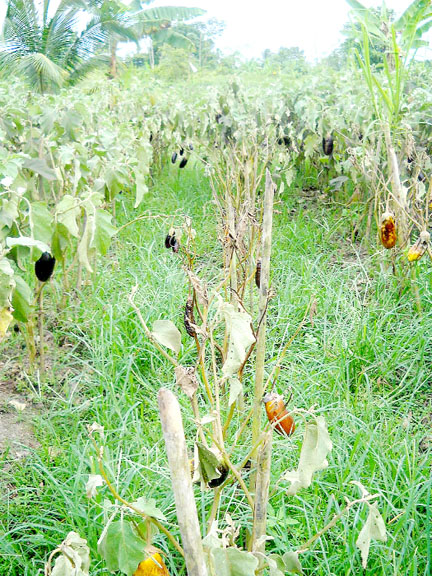‘We want a good road; without a good road, nothing doing’
(This is the seventh part in a series on the Grow More Food campaign)
Producing for years to supply the local market, farmers at Look-out, Parika and Naamryck, East Bank Essequibo say there have been changes in the agriculture landscape but little that encourages them to make the next leap.
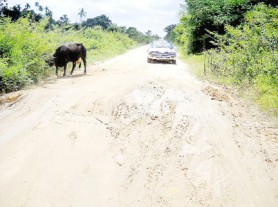
Many cite the limited markets and the lack of support that see crops time and again being wasted. In the Parika and Naamryck backlands, farmers are using sprinkler systems and even greenhouses to bolster their production, but said that it would require a great deal more investment to tap into export markets and most said that they had no intention of doing this.
Rupert Sooklall cites scripture on the “last days” as he talks about his farming. The veteran farmer once planted six acres of cabbage, ochro, bora and cucumber but has halved this because he cannot afford to cultivate more than three acres, he told Stabroek News during a visit last Wednesday. He now accepts whatever the market has to offer, he said. “Whatever they tell abhe, we got to accept,” he said noting that middle-men have their costs too. He has been farming for over 30 years and the market always fluctuates: “Sometimes when you want to sell for $10 and them offer you $5, you got to accept it.”
Sooklall has several other relatives farming at Look-out and Naamryck and it is their main source of livelihood. He utilizes a sprinkler system which he set up over ten years ago, taking advantage of the nearby Boersarie conservancy which provides a steady source of fresh water. He said that while input costs have increased, he earns enough to continue to farm, but “you can’t get nothing to put in the bank.”
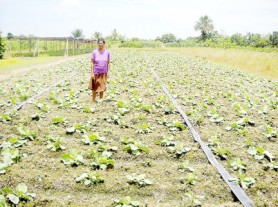
Sooklall disclosed that to hire a tractor to prepare an acre of land costs $22 000 while100 pounds of cassava, for example, is now selling for $1000. Additionally, he said, they continue to be affected by pests and fungus that destroy plants. Since the Grow More Food campaign began, Sooklall said he has received a bag of fertilizer but he was not sure which organisation or agency it was from. He expressed the view that some farmers were getting too much help.
Sooklall produces for the local market and said he has no time with exporters who have visited periodically. “Them exporter wasting time with people,” he said, adding that they want a certain size and quality of produce.
Farming done
Nankumar Nankishore is contemplating the next step after massive losses in his recent crop due to gluts in the market, particularly for cassava. He cultivates over 30 acres in ground provisions and cash crops at Look-out and Naamryck and has been farming for over 20 years. “Farming done. Agriculture done generally,” said the upset man. “When Cheddi dead, agriculture dead.”
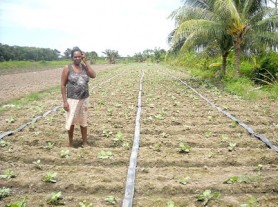
Nankishore related that he responded to the Grow More Food campaign by investing over $1M in his farming and is now left only with a “little change” in the bank.
There is no market, he exclaims. During a recent meeting with Agriculture Minister Robert Persaud at the Parika Back Primary School, the Minister had told farmers not to cultivate if there was no market, Nankishore recalled: “And he ah the man who tell you to grow more.”
“Agriculture nah get nothing like comeback in this country now,” Nankishore exclaimed. “Things dem nah sell,” he said pointing out that the inputs are costly and he is willing to make land available to agriculture officials for them to find out just what it takes to cultivates crops. “In the next couple days me gon got to destroy cassava,” said the farmer, who has planted about 20 acres of this crop. At the price of $5, $8 and $10 per pound, it does not pay to reap it, he went on: “You think it ah joke you got to destroy food. Is money and food you gat to destroy.” He and his entire family work on the farm.

Nankishore recalled that years ago he had built his home with the produce from three acres of land. He said that he has received nothing through the Grow More Food campaign and government has done nothing to assist farmers as it relates to inputs.
According to him, since the Parika Marketing Centre – which used to purchase produce from farmers, closed, “farming drop.” He said that he is examining his options, including selling out. During this newspaper’s visit to the location, areas of once cultivated land were pointed out where bushes are beginning to take over. “Me inside a shake foh know we gat to destroy that food. You think ah joke foh go and destroy all them thing deh,” he reiterated.
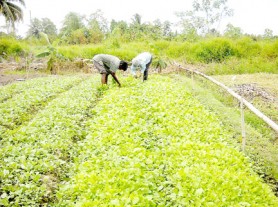
To assist farmers, Nankishore said, the government should ensure that fertilizers and drugs such as pesticides can be accessed cheaply. He also said there should be assistance in getting markets and eliminating the need for the middle-man. “The middle-man dem who ah kill farmers in this country,” he added.
Nankishore also said that certain assets should be made available duty-free to farmers. He recalled the Minister speaking about farmers accessing vehicles used for transporting their produce duty-free, and said he had tried. But, he continued, he had gone to the Guyana Revenue Authority with his documents and was told that he had to have 100 acres of land to qualify. “Me want foh know how much farmer got 100 acre land,” he said. He said he mentioned the issue to Guyana Marketing Corporation officials, whom he took to see the land he cultivates about three months ago, and they promised to respond to him, but up to now have not done so.
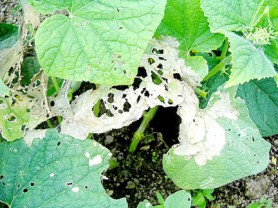
Nankishore said that he now would not be able to keep all his land under cultivation as it would cost too much and there is “no price” for his produce. “Me frustrated,” he said; “Investment and investment and you nah get back nothing.” He acknowledged that government has done work with regards to drainage and irrigation, but said that with regards to markets, something needs to be done. Nankishore said that he has got no help through the Grow More Food campaign. “Farming get rough. Not like before,” he remarked.
Profit
For Naresh Doobay, to factor his labour costs into the cost of production would mean that he is not making a profit. But “dah de living. Dah we grow pun,” he said philosophically.
Planting crops such as pak choy, eggplant, cabbage, pepper and cucumber on about three-and-a-half acres of land, he said that he has been farming since he was a small boy. He said that prices normally fluctuate: “sometimes you get, sometimes you lose.” He understands what other farmers are going through and so for now, he has employed a cassava farmer to help him, since the current glut in the market for cassava, saw the man being unable to make any money.
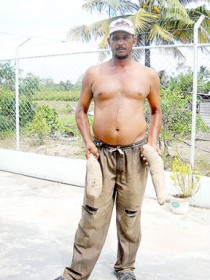
Doobay says that he only focuses on the local market. “These exporting people, you got to understand them a lot,” he said, explaining that they want the produce to be of a certain standard. “Me stick with me local market,” repeated Doobay; “If you got to get one size, you can’t produce these crops to one size.” For farmers like him, cabbage is one of the crops that despite the vigilance it requires, is profitable.
However, he said the Grow More Food campaign has little impact in moving farmers to another level. “Sometimes you grow more, yes, but when you carry it to market, they nah able tek it off,” he said. “Dem just a tell you grow more food but them nah really assist.” He said that he had received some assistance from the Canadian Hunger Foundation (CHF) but that was all. Markets are a “headache” he said.
Plant fungus is a major problem in the area and agriculture officials blame this on the weather pattern, Doobay said. He said it is a constant battle to control it.
He said that the Parika Back road is an area of concern pointing out that ‘crusher-run’ has been applied to the road many times only to have it deteriorate in a short time. “How long you gon deh pon dah,” he asked. But, he said while farmers face these problems, “dah the living and we gat to stick to that.”
Pamela Smith says she is retired but her sons continue their farm and she helps out.
They sell only to the local market, she said. Like others, they too have set up their sprinkler system to make watering the crops easier. In past years, markets were better than now because the marketing corporation used to buy their produce, she said. She related her experience recently where she carried three bags of sweet potato to the Parika Market and it did not sell. As for cassava, she said, the last occasion this was being sold it went for $700 for a bag. “It nah sell by pound. You nah weigh it and sell it cause what you gon do with it?” she queried. “Now it rough, rough to sell am.”
She said that they have received no assistance through the Grow More Food campaign.
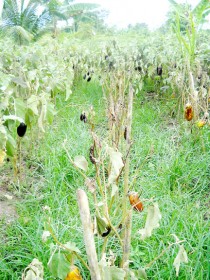
“Them a leff you, left you punish. Them ah tell you grow more but what the sense?” Smith said. “Now you ain’t even know what to plant,” she added. As for exporting, she said they have not done this, but if the exporters come and pay the price, and if they had the produce, they would sell to them.
A major concern of the area is plant fungus and they want the road leading out to the front of Naamryck done, Smith said. She said that residents had recently signed a petition for this but somehow ten of them are now being sued by a local official.
“We want a good road. Without a good road, nothing doing,” she said pointing out that during rainy weather they are forced to transport their produce by boat and the constant handling can lead to some blemishing of the produce.
Other farmers relate similar stories. One, who declined to be identified because he said he was one of those being sued by the local official, said he sells to the local market because producing for exporters does not work. “When dem man come, dem does tell we next week we gon come buy but they don’t come. Them a waste,” he said. He acknowledges that he is not actively looking for an export market. “You got to get quality thing,” he explained, going on to remark that to get to the standard required is hard with farmers like him who are unable to afford the inputs.
The man, who has been farming for over 25 years, plants three-and-a-half acres of land and said that they face issues such as the weather, pests and markets. The market is the most troublesome thing, he said. He noted that he had received some help from the CHF but from nowhere else. However, to bolster his production he set up a sprinkler system over a year ago and a greenhouse over two months ago. The Grow More Food campaign has not had much of an impact but they continue to farm and are surviving, he said.
Naamryck road
In late 2007, a $74.6M all-weather road constructed under the Poor Rural Com-munities Support Services Project (PRCSSP) of the Ministry of Agriculture for farmers in Naamryck, East Bank Essequibo was commissioned by Agriculture Minis-ter Robert Persaud.
A Government Informa-tion Agency (GINA) release had said that Persaud met farmers and commissioned the road while urging residents to ensure that they maintain it.
The release said further that Minister Persaud indicated that his ministry was working with farmers on several projects and would have liked them to develop their own nursery in the area with which the National Agricultural Research Institute (NARI) would assist.
During this newspaper’s visit, farmers said that the condition of the road deteriorates during rainy weather. The road connects to the Parika Back road through which farmers transport their produce to market. Some farmers have said, however, that they want the Naamryck road to be extended to the front of the community.

